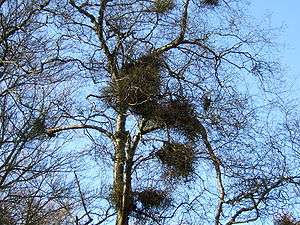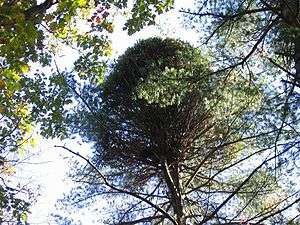Witch's broom


A witch's broom or witches' broom is a deformity in a woody plant, typically a tree, where the natural structure of the plant is changed. A dense mass of shoots grows from a single point, with the resulting structure resembling a broom or a bird's nest. It is sometimes caused by pathogens.
Witch-broom disease caused by phytoplasmas is economically important in a number of crop plants, including the cocoa tree Theobroma cacao,[1] jujube (Ziziphus jujuba)[2] and the timber tree Melia azedarach.[3]
Causes
Witch's broom can be caused by cytokinin, a phytohormone, interfering with an auxin-regulated bud. In normal plant function, an auxin would keep the secondary, tertiary, and so on apices from overgrowing, but cytokinin can sometimes interfere with this control, causing these apices to grow into witch's brooms.
Witch's broom may be caused by many different types of organisms, including fungi, oomycetes, insects, mistletoe, dwarf mistletoes, mites, nematodes, phytoplasmas, or viruses.[4] The broom growths may last for many years, typically for the life of the host plant. Human activity is sometimes behind the introduction of these organisms, for example, by failing to observe hygienic practice and thereby infecting the tree with the causative organism, or by pruning a tree improperly, and thereby weakening it.
Uses
Witches' brooms occasionally result in desirable changes. Some cultivars of trees, such as Picea orientalis 'Tom Thumb Gold', were discovered as witch's brooms. If twigs of witches' brooms are grafted onto normal rootstocks, freak trees result, showing that the attacking organism has changed the inherited growth pattern of the twigs.[4]
Witches' brooms are of wide ecological importance. They generally tend to be inhabited by a wide variety of organisms apart from the causative organisms. Some of the invading organisms, such as some species of moths, are specific to particular types of witches' brooms, relying on them for food and shelter for their larvae. Various larger animals nest in them, including the northern flying squirrel.[5]
See also
- Adventitiousness#Buds_and_shoots – atypical shoot development
- Epicormic shoot – a shoot that develops from buds under the bark
- Forest pathology
- In Toronto, the term 'witch's broom' is used to refer to the trolley pole on local streetcars.[6]
- Melampsora can cause different kinds of witch's brooms.
- Moniliophthora perniciosa, cause of witch's broom disease in cacao
- Phyllody, a related plant growth abnormality affecting flowers
- Witch's Broom Nebula
References
- ↑ Purdy, L.H.; Schmidt, R.A. (1996). "Status Of Cacao Witches' Broom: Biology, Epidemiology, and Management". Annual Review of Phytopathology. 34 (1): 573–594. doi:10.1146/annurev.phyto.34.1.573.
- ↑ Li Yun; Wang Yu; Tian Yanting & Sun Haoyuan (2001). "Advances in Tissue Culture and Eliminating of the Pathogeny of Witch Broom Disease(MLO) of Chinese Jujube".
- ↑ Gomez, G.G.; Conci, L.R.; Ducasse, D.A.; Nome, S.F. (1996). "Purification of the Phytoplasma Associated with China-tree (Melia azedarach L.) Decline and the Production of a Polyclonal Antiserum for its Detection". Journal of Phytopathology. 144 (9-10): 473–477. doi:10.1111/j.1439-0434.1996.tb00327.x.
- 1 2 Book of the British Countryside. Pub. London : Drive Publications, (1973). p. 519.
- ↑ "Home Page, Alaska Department of Fish and Game". Adfg.state.ak.us. 2012-01-01. Retrieved 2012-05-26.
- ↑ Micallef, Shawn (2008-09-14). "Red Rockets: I love to love you but sometimes it ain’t easy « Spacing Toronto". Spacingtoronto.ca. Retrieved 2012-05-26.
External links
![]() Media related to Witch's broom at Wikimedia Commons
Media related to Witch's broom at Wikimedia Commons
- Witches' Broom links to an article about witches' brooms on the BBC h2g2 website.
- Fir and spruce broom